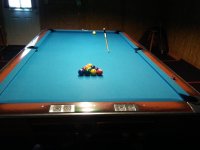i know it is widely advocated to not decelerate your stroke as you approach and on contact and follow thru with the cue ball
and it is widely advocated to accelerate your stroke as you approach and contactand follow thru the cue ball
i recently saw a video sorry i dont have the link where the person seemed to suggest a constant stroke speed which by definition is not accelerating
as you approach and contact the cue ball was not ideal for best "timing and action " on the cue ball
would like to hear what you all think ablut the pro /con of constant speed stroke and not accelerating
(i understand the cue ie stroke speed will momentarily slow down from the collision with the cue ball)
and it is widely advocated to accelerate your stroke as you approach and contactand follow thru the cue ball
i recently saw a video sorry i dont have the link where the person seemed to suggest a constant stroke speed which by definition is not accelerating
as you approach and contact the cue ball was not ideal for best "timing and action " on the cue ball
would like to hear what you all think ablut the pro /con of constant speed stroke and not accelerating
(i understand the cue ie stroke speed will momentarily slow down from the collision with the cue ball)
